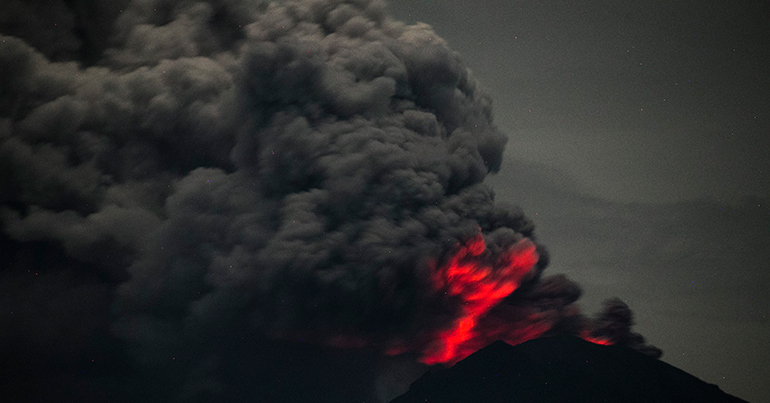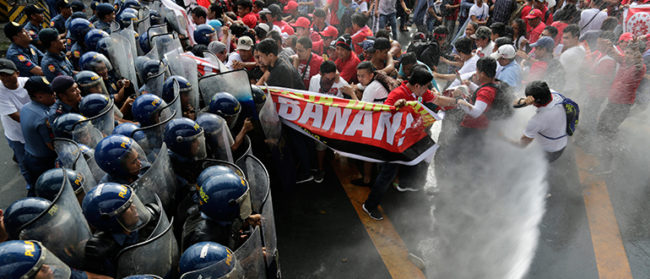Tsunamis, mudslides, and air pollution are risks linked to volcano eruptions. Here, we set aside what’s likely to happen (and not happen) after Mount Agung erupts

Mount Agung in Bali has been tempting to blow its lid for the past few months, but has come under the extra careful watch of Indonesian authorities in recent weeks as its been spewing off warning signs of ash and plumes of smoke metres into the air above.
While some experts are saying that the volcano will most likely erupt soon, they are unable to pinpoint exactly whether that will be a few days or a couple of weeks. This has led to a number of the people within the volcano’s immediate danger zone to resist being evacuated, citing job security as one of the potential reasons for remaining within the hazardous radius of the volcano. This resistance has also come despite several warnings being issued by government officials to evacuate the area.
Though no one can say for sure when the volcano’s eruption will occur, Scott Bryan, an associate professor of earth, environmental and biological sciences at Queensland University of Technology, has helped to outline what the aftermath is most likely going to look like, as well as debunk some of the other theories being pushed that are not likely going to play out.
Could the volcano’s eruption cool global temperatures?
Scientists have documented the cooling effect of volcanoes for some time now, showing how particles emitted from the explosion can sometimes create a shade-like effect for the incoming solar radiation that warms the planet. But in Mount Agung’s case, Bryan says this is unlikely.
“We saw the effects of SO2 following the 1991 eruption of Mt Pinatubo. This was a much bigger and more explosive eruption than Agung to date. For SO2 to have a real effect it needs to be injected into the stratosphere (more than 15 km high) and it must be in large quantities,” he said through an email interview.
Data from @NASA Aura satellite shows high SO2 concentrations from Mount #Agung yesterday in #Bali, #Indonesia. People on the ground witnessing the #volcano emitting thick ash clouds and glowing lava. More satellite imagery: https://t.co/oVYhIsjXNx pic.twitter.com/U3wPxQtfHc
— NOAA Satellites (@NOAASatellites) November 28, 2017
“At present, the eruption is only producing ash columns a few kilometres high,” he added. “There is unlikely to be any significant or measurable effect on climate if the eruption continues this way.”
Do Balinese people need to worry about a tsunami as well?
In 1883, Indonesia witnessed one of the most destructive tsunamis ever recorded. The 41-metre high waves were initially set in motion by the explosion and collapse of the volcano Krakatoa, which ultimately destroyed coastal villages in both Java and Sumatra.
Though these tsunamis have occurred in the past, Bryan doesn’t see it as an added threat for the people of Bali.
“Earthquakes have been occurring for some time and are naturally associated with volcanic eruptions. But the earthquakes tend to be lower in magnitude (less than magnitude 5) and thus not particularly devastating and won’t produce any tsunamis.”
How might air pollution be affected by the volcano’s eruption?
Depending on whether the eruption at Mount Agung is explosive (an eruption that produces more lava) or effusive (a more ash-heavy eruption, think like a shaken bottle of a carbonated drink) will ultimately determine how serious of a concern air pollution will be.
Since the mountain has been showing a greater tendency towards being explosive, Bryan says that air quality should be on everyone’s radar.
“Ash inhalation can cause irritation of lungs,” says Bryan, continuing to explain that there’s also a risk of developing silicosis, a chronic and incurable lung disease that’s caused from long-term exposure to irritants.
Volcano-types (explosive or effusive) explained by feeding from different magma layers, “L´Ecorce terrestre” (1874) pic.twitter.com/a15q7lZU2T
— David Bressan (@David_Bressan) March 24, 2016
With the added evidence of eyewitnesses on the ground reporting the scent of sulphur in the air in recent days, Bryan warns that the immediate ash fallout might lead to a case of fluorosis. This happens when people consume ash or drink contaminated water from fluorine that was leached from the ash into drinking water.
“If this eruption continues and water supplies become contaminated with ash, then care will need to be taken to avoid potential fluorine contamination.”
Are mudslides a risk?
In the 1963 eruption of Mount Agung more than 1,000 people died and one of the forces responsible for claiming these lives were the mudslides that were triggered shortly after the volcano erupted.
Bryan says that the probability and severity of these potential mudslides will all depend on when the eruption takes place.
“What will be more important is whether the eruption occurs during the wet season, [which would] then trigger mud flows or the dry season,” he said.
The mudslides will most likely be brought on if there is heavy rainfall following the eruption.
“[Mudslides] can be particularly devastating and last for months to years as we saw following the 1991 Pinatubo eruption in the Philippines.”
So why is everyone so concerned about this particular eruption?
It’s not really the size of the eruption at Mount Agung that is posing the main risk for the people of Bali – nor should it be causing the most worry – but rather the proximity and concentration of the people living next to the volcano.
“It is important to remember that despite the potential human impact of this eruption, the size of this eruption is likely to be relatively small; less than 1 km3 of magma is likely to be erupted,” said Bryan.
To put this in perspective, when Mount Pinatubo in the Philippines erupted in 1991 – the second-largest terrestrial eruption of the 20th century – it sent 6 km3 of magma shooting from its lid. And there have even been recordings of volcanoes sending more than 1000 km3 of magma upon eruption.
“The issue,” Bryan concludes, “is that because of human settlement patterns and population growth societal vulnerabilities, small eruptions can have a devastating effect on us. We are lucky to not have witnessed or endured a really large eruption in a highly populated, technology-dependent, and globally connected world.”
Scott Bryan is an associate professor of earth, earth systems, and environmental and biological sciences at Queensland University of Technology

